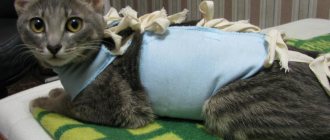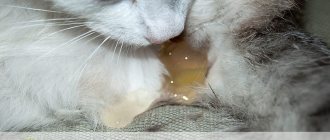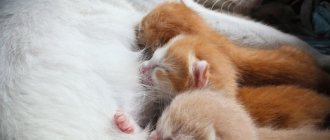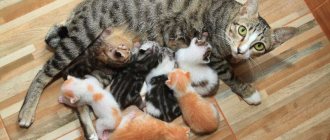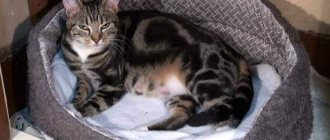Childbirth in a cat can occur with complications that cannot be predicted. Inexperienced owners often worry about their cat's condition if she takes too long to give birth. Let's figure out what interval between kittens can be considered normal and when it is better to seek urgent help from a veterinarian.
What signs should you look out for?
When it comes to the fact that a cat may not give birth to all kittens, then this situation poses a danger to the pet, even to the point of death.
A fetus that is not born will eventually begin to decompose in the womb, releasing toxic substances that are harmful to the animal. How to determine if everything is okay and what help to provide to your pet? The birth is not considered complete if:
- the cat after giving birth is not interested in kittens and does not lick them;
- refuses food and water;
- a day later, the cat’s temperature rose to 39 degrees or higher;
- when the fetus appears, the cat does not change position and continues to periodically push;
- the abdomen is hard and tense on palpation, the fetus can be felt;
- after 2 days, urine and feces are colored scarlet, and an unpleasant odor emanates from the pot.
The birth process in a cat occurs in 3 stages. First, the cat begins to moan and meow, the cervix opens, and the birth plug with discharge comes out. In the second phase, contractions become intense, the cat tenses, and kittens begin to emerge through the birth canal.
It happens that a cat runs away in fright or gets lost during the first lambing; in this case, it is important to re-examine the kittens and, if necessary, cut the bladder with sterile scissors so that the cub does not suffocate. At the final stage, the placenta is separated; it is important to ensure that the cat does not eat the afterbirth or the stillborn (weak) kitten
If all the rules are followed, but there are still concerns that the cat has not completely given birth, it is important to contact a veterinarian for help.
At the final stage, the placenta is separated; it is important to ensure that the cat does not eat the afterbirth or the stillborn (weak) kitten. If all the rules are followed, but there are still concerns that the cat has not completely given birth, it is important to contact a veterinarian for help.
Is there a chance to save a kitten during a caesarean section?
The doctor cannot guarantee that unborn kittens can be saved by caesarean section. Since it is possible that the fetuses died due to hypoxia due to their prolonged stay in the uterus. The operation is more necessary for the cat itself to save its life.
Sometimes surgical intervention cannot be performed urgently due to contraindications. This is due to the fact that the operation requires stable operation of all body systems, but if the animal has a violation of cardiac and respiratory functions, it may not withstand the load and die.
Be sure to read:
Miscarriage in a cat: symptoms, reasons, what to do, why kittens are born dead
If the kittens suffocated in the womb, and the decomposition process has already begun, performing a cesarean section is pointless, since necrotic changes spread to the uterine cavity.
This requires surgery to remove the organ and ovaries, since there is a high risk of developing septic complications and death.
Alarming symptoms
An unqualified owner cannot always help a furry pet. That is why during childbirth you should have the telephone number of the treating veterinarian, or preferably two or three numbers, at hand. Four symptoms are a serious reason to contact a specialist.
Ahead of schedule. Most often, premature birth occurs in a cat due to a frozen pregnancy, non-viability of the offspring, placental abruption, or trauma. The stages of labor pass faster already on the 50-55th day, sometimes earlier. Most often, a cat gives birth to dead kittens. The living premature offspring dies in the coming days. It happens that a cat gives birth to just one dead baby prematurely. The rest emerge alive and healthy on time. If your cat gives birth prematurely, have her examined by a specialist to understand further steps. Lack of childbirth. If the pet does not give birth for more than 70 days and if this is not a false “birth” due to an imaginary pregnancy in the cat, then the pregnancy is probably frozen. The cubs most likely died, so it is urgent to save the pet from possible infections and damage to the uterus. Missed birth
It is important to determine when labor is truly over. If the pushing has stopped and the cat is resting, this does not guarantee that all the kittens will come out.
You should observe your mother's behavior. A cat that has not yet given birth reluctantly takes care of the cubs, does not leave the “nest” and does not change position, refuses to drink, and periodically strains. To make sure, you can feel the stomach three to four hours after birth. The elasticity and tension of the muscles indicate that there is still a kitten left in the womb. Discharge. Any colored, pungent-smelling discharge during pregnancy and childbirth is a deviation from the norm. During strong, long contractions (more than an hour) without subsequent labor, blood may flow profusely. In this case, it is also necessary to show the cat to a specialist.
Fetal pathologies do not always depend on the health of the mother and can be inherited from the father. However, the physical and mental condition of the cat affects the successful outcome of the birth.
Therefore, it is important that the pet is healthy before mating. Unfavorable factors for childbirth are old age, obesity, stress, heredity
Even the process of childbirth in a cat, supported by instincts, does not always go smoothly. You should mentally prepare for any outcome. However, do not panic prematurely and do not intervene without reason. Nervousness will be transferred to the pet, and during childbirth she will be confused. Rest assured that everything will go well and the cat will be able to rely on its owner.
This simple question is asked not only by experienced breeders of the breed, but also by ordinary owners of furry four-legged animals who expect a new addition to the family in the near future. But really, how can you tell if a cat is about to give birth?
? Let's try to figure this out.
What we can do?
Since incomplete delivery can have tragic consequences, action must be taken immediately. Assuming that the kitten remains in the cat's womb for more than 24 hours after the end of labor, immediate action must be taken.
To expel the fetus remaining in the uterus, labor is stimulated with oxytocin at the rate of 0.3 ml. You can do this yourself, but seek help from a veterinarian. The doctor will calculate the exact dose of the medicine to ensure it is safe and effective. The administration of oxytocin often causes individual reactions; its administration is prohibited in the presence of transverse presentation and other pathologies.
The use of oxytocin has a positive effect on the termination of labor and promotes the removal of postpartum discharge in the uterus. Once the required result is obtained, a new diagnosis is made to determine whether kittens remain in the cat's uterus.
When providing obstetric care to a cat, the owner must be vigilant in order to know the basic characteristics of the cat's physiological structure. This will help to understand whether the process has completed or whether the kitten remains in the belly of the tailed animal. If there are any doubts about the end of labor, you should immediately seek qualified help from a special institution. Prompt action will help preserve the cat’s reproductive function, and in some cases, its life.
The main signs of the end of labor
When a cat gives birth, it is important to make sure everything is successful in the end. This can be judged by the presence of the following signs:
- As soon as the mother realizes that all the kittens are out, she begins to actively care for the offspring, feeding them milk. At the same time, the cat intensively licks the babies, feeds them, purrs;
- If you listen to your breathing, you will find that it is even. Heart beats and pulse are rhythmic and follow at a normal speed;
- Mom eats and drinks with pleasure;
- the pet is able to get up and walk at least a little;
- when labor ends, if palpation is done no earlier than 40 minutes later, the abdomen will feel soft and relaxed to the touch. When palpating, you cannot feel the presence of seals. The muscles may be tense for a short period of time, but this quickly passes.
An indirect sign of a favorable end of labor may be the natural and calm behavior of the pet. However, it is normal for some cats to remain calm even when giving birth.
Birth of the fetus
As soon as the kitten comes out, it is covered in a shell. The mother must carefully tear it apart and bite off the umbilical cord. The cat begins to intensively lick the baby, which helps clear his respiratory tract of mucus. The kitten should squeak - this is a sign that it is breathing. After or along with the kitten, the placenta comes out, which the mother can eat. If the offspring is large, you should not let her eat more than 3 afterbirths.
You need to make sure that all traces come out. Their number should correspond to the number of fruits. The placenta remaining inside can cause serious inflammatory diseases.
In the intervals between births, it is necessary to ensure that the mother does not lie on the newborn kitten. Due to the pain and discomfort, she may not notice it and accidentally press it down.
We suggest you read: Is it possible to cross a fold-eared cat with a fold-eared cat: why not?
When all the babies are born, it is necessary to organize complete peace for the family. The mother will lick and feed her babies, so there is no need to disturb them too much. If a cat has eaten the afterbirth, she may not eat for several hours after giving birth. It is necessary to leave her something to drink and place a toilet nearby so that she does not go far from the offspring.
How does the feline birth process work?
Cats bear offspring for about 64 days, in rare cases - up to 70 days. On average, there are 3-5 kittens in a litter, but cases of the birth of eight cat cubs have been recorded. The duration of labor is influenced by several factors: age, number of fetuses, number of previous lambings, breed, diet during pregnancy. On average, the process of childbirth in cats takes from several hours to a day and a half, and includes periods of contractions, pushing and expulsion of the fetus.
The cat's first contractions may be invisible to others because they are still weak. At this time, your pet can be busy arranging the nest. As the contractions intensify, the cat may moan, meow, and its body periodically tenses in efforts. Then the cervix opens, the mucous birth plug emerges through the birth canal, followed by the first kitten.
Kittens are born “in order”, usually with a break of half an hour to 12 hours. Their birth may alternate with the expulsion of the placenta, which the cat sometimes eats. Kittens are born in the embryonic membrane (amniotic sac), the cat chews it, licks the cub, then bites the umbilical cord. The mother can begin feeding already born kittens in between contractions.
If your pet ignores the newborn kitten, the owner present at the birth will have to open the amniotic sac himself, carefully wipe the kitten and place it next to the mother. During the birthing process, your cat may need several hours of rest.
It is difficult for an inexperienced cat owner to understand whether all the kittens have already come out, or whether this is a break in childbirth. Even an ultrasound scan performed during pregnancy does not always reliably determine the exact number of fetuses. You can focus on the signs of the end of the birth process
During the birthing process, your cat may need several hours of rest. It is difficult for an inexperienced cat owner to understand whether all the kittens have already come out, or whether this is a break in childbirth. Even an ultrasound scan performed during pregnancy does not always reliably determine the exact number of fetuses. You can focus on the signs of the end of the birth process.
Contractions and birth of kittens
The process of giving birth to kittens can be divided into two stages:
- The beginning of labor. The uterus begins to contract, the first not too intense muscle contractions appear. At this time, the kittens are preparing to “go out” and line up before passing through the birth canal. At the first stage, it is not always possible to understand that a cat is having contractions. They are invisible and do not cause significant pain, so the animal will not react strongly to them. Contractions will usually recur at intervals of 30-40 minutes. Gradually, the interval will shorten and the duration of the contraction will increase. This period can last 8-10 hours.
- Passage through the birth canal. The grips intensify, the interval between them is reduced to 1 minute. Muscle contractions become distinct and are easy to see with the naked eye. Final contractions are prolonged muscle contractions, also called pushing. They push the kitten through the birth canal. Due to the increase in the intensity of contractions, the fruits begin to come out.
From the onset of the first contractions to the birth of the offspring, it can take about 12 hours. If kittens are not born for a longer period of time, you should seek help from a veterinarian. During prolonged inactive labor, the fetus may experience hypoxia - oxygen starvation, which negatively affects its health and can lead to death.
On average, labor lasts about 24 hours in total. Everything will depend on the number of fruits, the health of the animal, and external factors. Kittens can appear one after another with an interval of 15-30 minutes (sometimes up to 1 hour). During this time, the cat will continue to have contractions with short breaks between attempts.
In primiparous cats, contractions may last longer than in animals that have already given birth. However, this statement is not an axiom. Primiparous cats can cope with the birth of their offspring just as successfully as experienced mothers. At the same time, complications are not excluded during the second and third births. This process should always be monitored, since the pet may need help at any time.
The following signs indicate the end of labor:
- no contractions for more than 3 hours;
- the stomach has become soft, the muscles are not tense, the fruits cannot be felt in it;
- The cat behaves calmly and rests.
To know exactly how many kittens should be born, it is recommended to do an ultrasound first.
Signs of the end of labor
After forty minutes, the mother’s belly becomes soft.
The first symptom is active care of the offspring. The animal diligently licks the kittens, purrs, and feeds. The pet breathes evenly, the pulse and heartbeat are stably rhythmic and do not go beyond physiological parameters. After a short time, the cat shows interest in food and drink
The pet can get up from the nest and leaves its brood for a while. After forty minutes, the mother’s abdomen becomes soft; palpation does not reveal any lumps. However, the uterus may remain in good shape for some time, which can be mistaken for a kitten. In this case, you should not squeeze the cat’s stomach too much; you should place both hands on the sides of the animal and carefully move along the ribs. It is recommended to check after the forty-minute period has expired. An additional sign is the cat’s calm behavior, but due to the fact that some mothers behave calmly even during childbirth, this sign is not a 100% guarantee.
How to understand that a cat is giving birth: main signs
On average, pregnancy in cats lasts 65 days (plus or minus 5 days). This period usually guarantees the birth of healthy kittens. But how to know that a cat is giving birth - not every person knows the signs of this event. Many inexperienced owners begin to worry about the upcoming event as soon as they notice that their pet is pregnant. The owner of a cat who is about to give birth for the first time experiences special experiences. And the pet itself often shows anxiety. And I must say: not in vain.
But don't worry too much. You will have enough time to become familiar with the cat's behavior during this period and prepare the necessary supplies for giving birth at home. First, let's try to understand what signs can be used to guess that a cat is pregnant. It will be easiest to recognize an “interesting position” and calculate the date of fertilization if the mating was planned, and you know from what point to keep a record of the pregnancy, which is conventionally divided into three stages with characteristics characteristic of each.
How to handle newborn kittens
After making sure that all kittens are freed from the amniotic sac, it is necessary to clear their airways. This can be done with a regular syringe without a needle or with a back massage. Then all kittens need to be rubbed with a soft, clean towel.
Newborn kittens are still deprived of sight and hearing and rely only on the owl's sense of smell and instincts, so they find their mother's milk by smell.
Life of kittens by week:
- In the second week of life, kittens' eyes open and they gain weight;
- After 4 weeks, the kittens are already stronger and can play and crawl on their own;
- During the same period (4 weeks), the kittens begin to develop their first teeth;
- At 8-12 weeks, kittens experience a little stress as the cat stops feeding them milk;
- After 5 months, the kittens successfully begin a war for territory (they begin to mark corners);
- After six months of life, kittens become completely independent and do not need a mother;
When giving birth to a cat, you must remember that each one has individual characteristics of the body. Therefore, each birth takes place in its own order, in which the body is programmed. If a cat gives birth for the first time, then the owner needs to constantly be near the woman in labor and be in a calm state. Cats are excellent empaths and are able to take on their owner’s anxiety and nervousness.
Source
How to prepare a cat for childbirth?
In the last week of pregnancy, it is recommended to protect the cat from stress as much as possible. The expectant mother's bed, tray and bowls must be moved to the most remote and quiet room
It is important that there are no drafts in the room and a constant temperature regime is maintained.
1-2 weeks before giving birth, most cats begin what is called nesting. The pet is looking for a secluded, dark, quiet and warm place in which she will give birth and raise kittens.
In most cases, cats prefer to make a nest in closets or under the bed. The expectant mother, who has free access to the street, is likely to build a nest outside the house, for example, under a threshold or in an improvised hole.
Note that giving birth to kittens in a closet is convenient for the cat, but not for the owner. Monitoring the growth and development of kittens involves regular weighing. Temperamental and primiparous cats may become protective of their offspring, making kittens difficult to obtain. By arranging a nest for a cat and her future offspring in advance, you will eliminate a number of problems in the first month of the kittens’ life.
As a nest, you can use special boxes that are sold in a pet store or a regular, durable cardboard box. Experience shows that cats prefer to build their nests in a closed box with a roof. The side of the box is cut so that the cat can easily step over the threshold without clinging to its stomach.
During the birth process, the bedding in the box will be wet, so it is recommended to stock up on moisture-absorbing diapers. For the first 4–5 days after birth, until the babies' umbilical cords fall off, it is recommended to use only white cotton fabric as bedding. On white bedding, you will immediately notice dirt or suspicious discharge from your cat.
In addition to arranging the nest, you need to take care of preparing an emergency first aid kit. If the birth occurs without complications, your intervention will not be required.
In case of difficult labor and the need to open the amniotic sac, you will need several pairs of sterile surgical gloves. If the cat refuses to lick the kittens, amniotic fluid must be removed from their respiratory tract, and for this it is convenient to use a baby syringe or a syringe with a soft tube.
For any complications during the birth process, it is recommended to contact a veterinarian. Arrange in advance with your doctor about telephone consultations and home visits, if necessary.
In rare cases, the umbilical cord vessels do not close, so they have to be ligated. You can use strong cotton, nylon or dental floss as a dressing.
Use sharp, sterile scissors to cut the umbilical cord. Pour boiling water over the scissors in advance or treat them with alcohol, then place them in a clean bag and do not take them out until delivery.
In addition to moisture-absorbing diapers, which are used as bedding, you need to stock up on a large number of cotton pieces to wipe and wrap the kittens.
Just in case, prepare several terry towels that retain temperature well. In case of complications, you will have to remove the kittens from the nest, so a spare box of bedding and a heating pad will be useful.
After the first or difficult birth, some cats refuse kittens, that is, they ignore and do not feed them. To take control of the situation, buy several packets of milk replacer and a kitten feeding bottle in advance.

